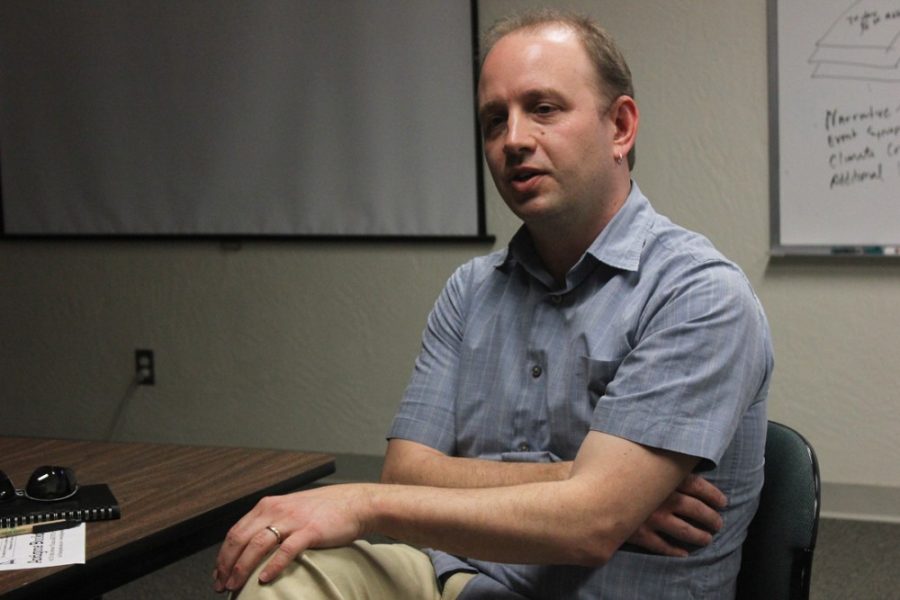Friday from 7-8:30 p.m., Eric Magrane, poet-in-residence at the Arizona-Sonora Desert Museum, will speak at Antigone Books to talk about the connection between poetry, art and the natural world. The Daily Wildcat caught up with the poet before the event.
Daily Wildcat: How did you start writing poetry?
Magrane: I studied poetry in college and then I did a Masters in Fine Arts [in Creative Writing] here a few years back, and I was drawn to poetry because of the way a poem would help me to slow down and pay attention to the places I was at […] and help me understand the world and how I, and others, interact with the world. It’s a way to really think [about] language and distilled form, and it’s a kind of meditation in some ways as well. Poetry helps me make sense of the places that I find myself.
How has your work at the UA inspired your poetry?
I do work that blends creative work and environmental research, so the work I’m doing with the Desert Museum and the [UA] Poetry Center is a perfect way to do that, because we are using poetry within the Desert Museum grounds to help tell the story of the Sonoran Desert in new and surprising ways […] that are different from traditional signage but ways that surprise visitors and encourage visitors to think in other ways about conservation to other species. […]That’s a question I [address] in my research in geography as well. I study how humans and non-humans interact with their environment, so being able to work with the Desert Museum and the Poetry Center helps me to bring those things together.
You mentioned you studied poetry in college. What were your other focuses?
I’ve studied sculpture and environmental studies. I’m currently finishing a doctorate in geography. So my work and my education has blended creative disciplines with scientific disciplines, and that forms a lot of the projects I get involved with as well.
When did your relationship start with Miss Marple the ringtail?
Staring last fall, Miss Marple and I, as well as others, including Tyler Meier, the director of the Poetry Center, and other[s] from the Desert Museum, have done a number of public presentations, and what happens in these presentations blends myself reading poetry and talking about the project, placing poetry within Desert Museum grounds and also Miss Marple coming out.
How is it working with Miss Marple?
It’s good. She works really close with the keepers at the Desert Museum. There is a large group of folks who work with animals, so when she comes, she’ll come with one of the animal experience specialists.
What is something you enjoy about poetry and/or Miss Marple?
I enjoy the places poetry can bring me. I go to poetry for a lot of the same reasons I like to go outside or I like to go into nature. Poetry has a type of wildness to it that I really appreciate and look for. It helps me to understand or ascertain our place in the world in ways that I didn’t know beforehand. … Poetry to me is about relationship[s]. The relationship between different humans and other species and between humans and the earth. I [revisit] both poetry and nature to experience that myself, to refresh and to be surprised.
What fascinates you about the creative process part of your research?
Geography helps me to think about place and environment in very detailed ways. There’s a long history of geography to think about place and environment, and bringing creative projects to thinking about place and environment really helps have a more detailed understanding of the various ways we understand place and environment but also bring that understanding to the creative practice as well [because] it helps tell those stories, but also helps think about what those stories do in the world, how they affect the way we organize ourselves in the world.
What do you hope people will take away from your work and attending the event?
I hope they’ll have fun and that they’ll hear some poetry, enjoy the poetry [and enjoy] the interaction with Miss Marple. It’s fun having a ringtail, state mammal, in a bookstore, and we’ll see what happens. I hope they’ll also hear more about what we’re doing at the Desert Museum in collaboration with the Poetry Center, so it’s a chance for people to ask about that project.
_______________
Follow Ivana Goldtooth on Twitter.









